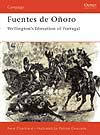Book
Review:
Fuentes de Onoro: Wellington’s Liberation of Portugal
By
Rene Chartrand
Artwork by Patrice
Courcelle
 The
third French invasion of Portugal was a poor strategic effort
from an ageing Marshal Massena, whose once formidable military
skills seemed to have deserted him.
The
third French invasion of Portugal was a poor strategic effort
from an ageing Marshal Massena, whose once formidable military
skills seemed to have deserted him.
Advancing
full of confidence, Massena’s army was given a horrible and bloody
shock at Bussaco by the British under the Duke of Wellington.
Shaken
by that battle, in which they lost more than 4500 men, the French
continued on towards Lisbon with a view to forcing the British
to withdraw from Portugal.
Then
they struck the Lines of Torres Vedras, strong defence works built
upon mountains that rise up north of Lisbon.
To
the French they were a total surprise and forced them to face
a choice – retreat or starve in a land denuded of forage.
Massena
chose to stay, although he was eventually forced away by the lack
of supplies, and in a last-minute bid to save his command – he
had been sacked by Napoleon Bonaparte – chose a small village
called Fuentes de Onoro to try to prove he was not finished as
a great commander.
The
resulting battle was a test for the British as Massena showed
his true abilities and made things hot for Wellington.
In
Fuentes de Onoro: Wellington’s Liberation of Portugal,
author Rene Chartrand explains the lead-up and development of
the important battle in a truly excellent way.
Chartrand
outlines the problems within the French army with disunity and
low morale and the shock the leadership had when it stumbled on
to the Lines of Torres Vedras.
He also details the lines and gives credit to the Portuguese engineers
who seem to have been slightly overlooked by other historians.
With
his army starving Massena had several choices – including a fairly
sensible one of moving over the passable northern parts of the
Tagus River and occupying the eastern bank of the waterway thereby
threatening British access to Lisbon.
It
didn’t happen though and Massena retreated towards Spain, sacked
Marshal Ney - who was furious with his senior colleague’s strategic
decisions – and then turned to take Wellington on at Fuentes de
Onoro.
Chartrand’s
description of that clash is terrific and by the time you’ve finished
the book you’ll have an excellent grasp of the battle.
There
are a huge number of photographs showing key areas and buildings
of the battle, along with contemporary images and 3D maps of the
field itself.
Artist
Patrice Courcelle has two major works in the book – a detailed
look at Allied gun emplacements and a superb image of French dragoons
riding down some hapless British infantry at Fuentes de Onoro.
Fuentes
de Onoro: Wellington’s Liberation of Portugal is a must-have
for those wanting a better understanding of the Peninsular War.
-
Richard Moore
9/10
Osprey
Website
Osprey
PO Box 140,
Wellingborough,
Northants,
NN8 2FA,
UK.